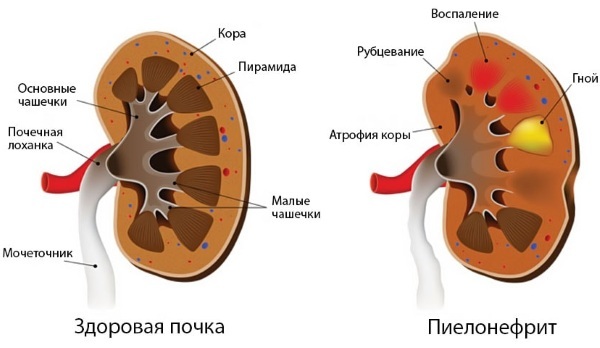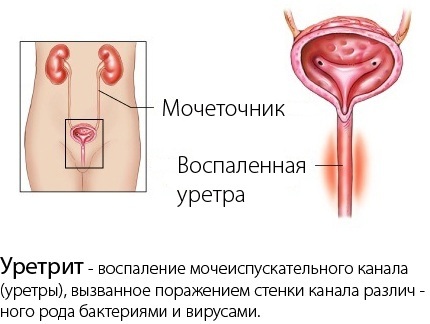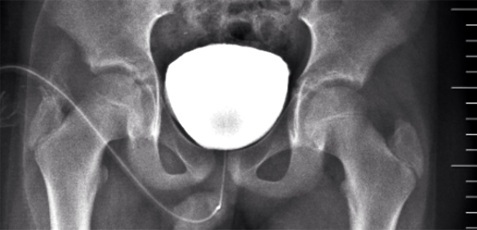Depending on the degree of development of the inflammatory process, the affected area and the state of the child's body, urinary tract infection manifests itself in various clinical symptoms.
The cause may be factors of an infectious or non-infectious nature. It is necessary to undergo a comprehensive examination, pass a number of tests in order to establish an accurate diagnosis. The treatment is carried out by a pediatrician or urologist.
Record content:
- 1 general information
- 2 Classification
- 3 Causes and predisposing factors
- 4 Symptoms
- 5 When to Seek Help
- 6 Diagnostic methods
-
7 Treatment of urinary tract infections in children
- 7.1 Drug treatment
- 7.2 Folk remedies
- 7.3 Other treatments
- 8 Consequences of UTI
- 9 Video about urinary tract infection in children
general information
Pediatric urinary tract infection (UTI) is characterized by an inflammatory process that affects the organs of the urinary system. The causative agents are pathogenic microorganisms, bacteria. Due to the anatomical structure of the female body, urinary tract infection is more often diagnosed in girls.
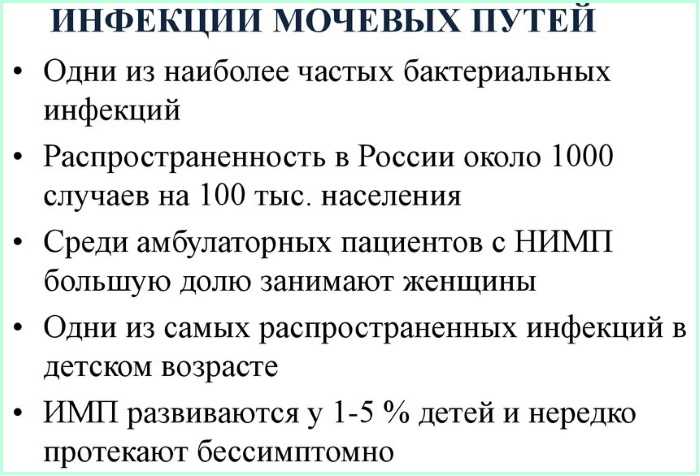
Infection of the child's body occurs in the following ways:
| Name | Description |
| Hematogenous | Pathogens of pathological processes enter the child's body through the blood. This is more true for young children. Pathogenic microorganisms enter the organs of the urinary system through the blood after pneumonia or purulent omphalitis (inflammation of the navel). |
| Lymphogenous | The causative agents of the infectious process enter the organs of the urinary system with the flow of lymph. |
| Ascending | The infection enters the child's body through the external genitalia. More common in girls. This is due to the anatomical structure of their genitourinary system. |
Often, children are diagnosed with pyelonephritis, cystitis, asymptomatic bacteriuria. Premature babies with anemia, malnutrition or immunodeficiency are at risk.
Classification
Urinary tract infection in children (symptoms will help the doctor establish a preliminary diagnosis and prescribe the patient the most informative comprehensive examination) classified according to certain factors: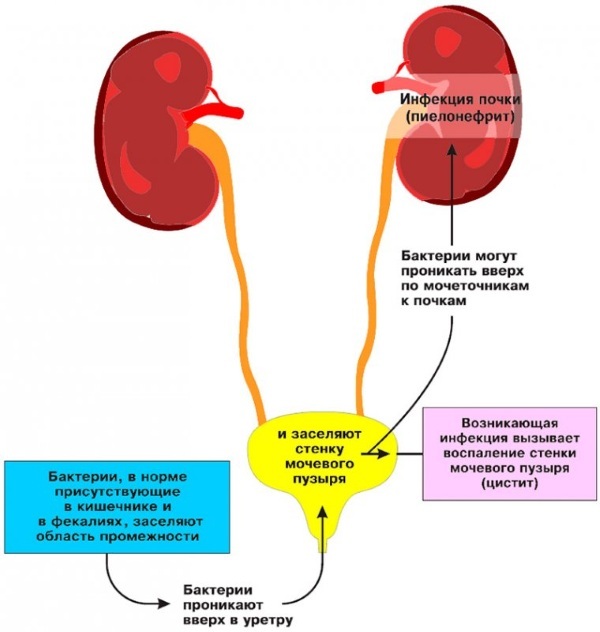
| Name | Description |
| Place of localization of the inflammatory process |
|
| The nature of the course of the inflammatory process |
|
| Infection routes |
|
| Accompaniment of clinical signs |
|
| The course of the inflammatory process |
|
Each form of urinary tract infection is accompanied by characteristic clinical symptoms. A pediatrician or urologist will help to establish an accurate diagnosis.
Causes and predisposing factors
Urinary tract infection in children (symptoms require a comprehensive examination and correctly selected therapy) in most cases occurs against the background of infection of the body with enterobacteria, intestinal with a stick.
There are also numerous provoking reasons:
- weak immunity;
- violation of material metabolism;
- pathological changes in the renal vessels;
- diseases of the reproductive system;
- infection of the child's body with parasites;
- intestinal lesions;
- hypothermia of the whole body or the kidneys themselves;
- surgical intervention, during which the infection was brought in;
- pathology of an infectious origin of the gastrointestinal tract;
- abnormal structure of the organs of the reproductive system.
Parents should teach their child simple rules of personal hygiene. Failure to comply with them increases the risk of infection of the child's body.
The following people are at risk:
| Name | Description |
| Women and girls | The anatomical structure of the body increases the risk of infection of the organs of the urinary system. This is due to the proximity of the vagina, urethra and anus. Through the short and wide urethra, pathogenic bacteria enter the urinary system, affecting its channels. |
| Children under 3 years old | Inadequately formed immunity has low resistance to various infections. |
| Elderly people | The reason is age-related immunodeficiency. |
| Patients with renal pathologies | Kidney disease increases the risk of developing an inflammatory-degenerative process in the urinary tract. |
| Children with anatomical features | Congenital abnormalities can interfere with the flow of urine, which can also trigger a urinary tract infection. |
| Resuscitation patients | The child is periodically placed a catheter through which the infection enters the body. |
| Patients with chronic pathologies | Such diseases reduce immunity and defenses, against the background of which the body's resistance decreases. |
In childhood, urinary tract infection also occurs against the background of obstructive processes, a variety of functional disorders. The same applies to stagnation of urine, congenital abnormalities of the urinary system.
Symptoms
The clinical picture of urinary tract infection in children depends on places of localization of pathological processes: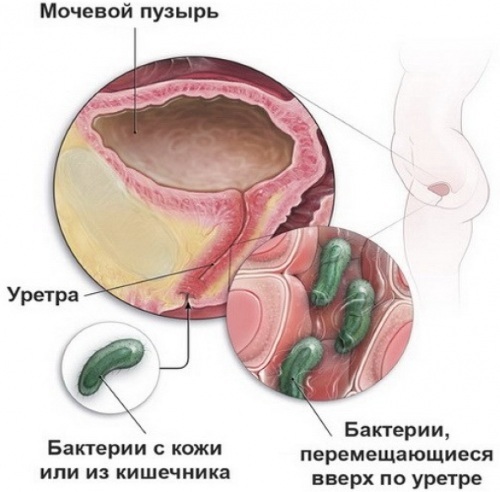
| Name | Symptoms |
| Pyelonephritis | The infectious agent affects the kidneys. The child shows the following symptoms:
|
| Cystitis | The disease is characterized by inflammation of the kidneys and is accompanied by the following clinical symptoms:
|
| Urethritis |
|
Urinary tract infection in children is also accompanied by common symptoms:
- soreness and burning during urination;
- urine acquires a pungent smell, its color changes;
- the release of urine with frequent urge in a small amount;
- the temperature rises as the body's reaction to the inflammatory process;
- symptoms of intoxication appear (nausea, vomiting, dizziness, general weakness of the body).
The infection is also accompanied by intense thirst, poor appetite, drowsiness, and frequent trips to the toilet.
When to Seek Help
It is necessary to visit a pediatrician or urologist immediately when the first clinical signs of urinary tract infection appear. Timely comprehensive diagnostics and correct diagnosis are important for drawing up an effective treatment regimen.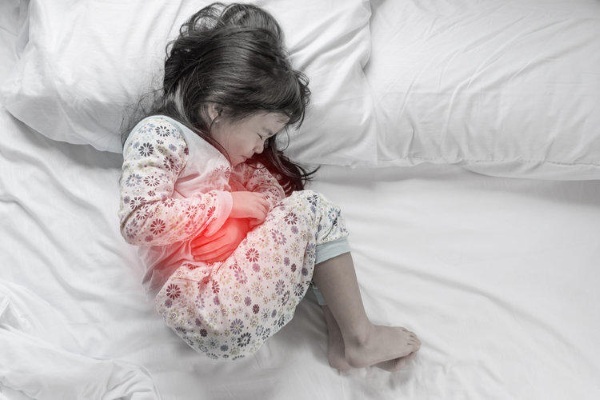
Violations cannot be ignored, since pathological processes in the urinary system will progress. The child's condition will worsen, against the background of which other complications will arise.
Diagnostic methods
A child must undergo a comprehensive examination so that a pediatrician or urologist can establish an accurate diagnosis. If necessary, the little patient is shown an additional consultation with a gynecologist, nephrologist, nutritionist.
To determine a urinary tract infection in a child, the following diagnostic measures are prescribed:
| Name | Description |
| Microscopic examinations | A general urine test helps to determine the inflammatory process and assess the general condition of the child's body. |
| Using test strips | An effective diagnostic method that allows you to determine the infection of the urinary tract at an early stage. The tests are 98% informative. |
| Blood analysis | General, serological and biochemical blood tests. Research will help specialists determine the type of infectious agent. |
| Bacteriological culture | Determined not only the type of pathogenic flora, but also its resistance to antibacterial drugs. |
| Instrumental methods |
|
Some diagnostic methods are prescribed for chronic urinary tract infection in children. Medical manipulations are carried out strictly during the period of remission of the pathology. It is important to differentiate the infectious process, since many diseases of the urinary system are accompanied by similar clinical signs (vulvovaginitis, enterobiasis, appendicitis, balanitis).
Treatment of urinary tract infections in children
Urinary tract infection in children (symptoms will help determine the degree of development of the inflammatory process and the area of canal damage) requires complex therapy. The child is prescribed certain medications after diagnosis based on the results obtained.
If there are no serious contraindications, you can use folk recipes, having previously discussed their use with your pediatrician or urologist. It is also important to stick to a diet to reduce the stress on the urinary system.
Drug treatment
The drugs are selected by the doctor after a comprehensive examination based on the results obtained. It is important to strictly adhere to the treatment regimen and dosage, since many drugs provoke the appearance of side effects.
| Drug group | Name | Application |
| Antibacterial agents | Amoxicillin, Gentamicin | The medicine acts directly on the causative agent of pathological processes. Children's dosage is 125-250 mg 3 times a day, taking into account the age of the small patient. The course of therapy lasts 5-12 days. The time interval between doses of the drug should not be less than 8 hours. |
| Non-steroidal anti-inflammatory drugs | Nurofen, Paracetamol | The drugs reduce body temperature and pain. The therapeutic dosage depends on the child's age and body weight. On average, children are prescribed 2.5-15 ml 3 times a day. The course of treatment lasts 3 days. |
| Antispasmodics | Papaverine, Drotaverine | The medicine is taken orally with a sufficient amount of water or intramuscularly, subcutaneously. The pediatric dosage is 5-20 mg 3-4 times a day, depending on the age of the patient. |
| Probiotics | Linex, Bifidumbacterin | The drugs restore the normal balance of microflora. Capsules are taken with meals or after meals with a little water. Children are prescribed 1 tablet 1-2 times a day. |
| Antihistamines | Loratadine, Clemastine | Medicines are prescribed for children at 5 mg per day. The minimum course of therapy lasts a week. |
| Uroantiseptics | Kanefron, Furamag | The medicine is taken orally, pre-diluted with a small amount of water. Children, depending on age, are prescribed 10-25 drops 3 times a day. The course of therapy lasts 2-4 weeks. |
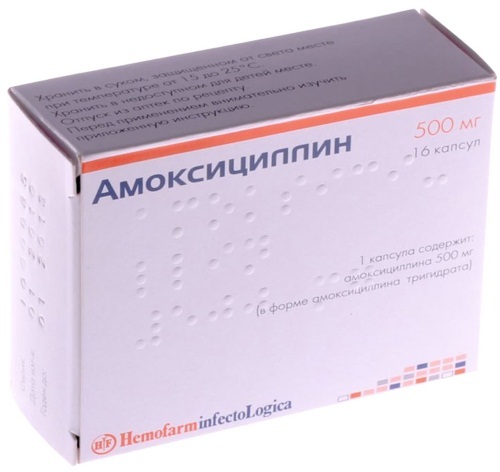
In addition, the pediatrician prescribes vitamin complexes for the child, which will help strengthen the immunity of the child's body. Hospitalization is required if the child is less than 2 years old, if there are symptoms of severe intoxication of the body, complications or re-infection.
Folk remedies
Urinary tract infection in children (symptoms help identify the disease early) is treated complex methods and provides for the use of recipes of healers and healers, but only after consultation with by the attending physician.
Many of the ingredients used can aggravate a child's condition or provoke an allergic reaction. We must not forget about individual sensitivity.
Effective folk remedies for infection of the urinary system:
| Name | Recipe | Application |
| Garlic | Peel and crush 2 cloves of garlic, pour warm water over them. Insist the resulting solution for 5 minutes and drink. | The medicine is recommended to be given to children 3 times a day until the symptoms of urinary tract infection disappear. Garlic, as a traditional healer, effectively deals with various bacteria. |
| Apple vinegar | Dilute 2 tbsp in 1 liter of water. l. apple cider vinegar. | The child needs to drink the resulting mixture throughout the day in small portions. |
| Healing cocktail | Grind 2 celery stalks with leaves. Add 3 liters of water, 2 slices of pineapple and 1 tbsp. chamomile infusion, pre-strained. | The finished product is recommended for children to drink on an empty stomach every morning. |
| Bath | Mix in equal parts thyme, ponytail, calendula and flax seeds (4 tbsp each) l.). Pour everything with warm water, put on fire and heat for 10 minutes. Insist 15 minutes and drain. | The ready-made broth is used for sitz baths. Herbs have disinfectant and anti-inflammatory properties. |
| Garlic with honey | Mix 1 clove of garlic minced in a mortar and 2 tbsp. l. natural liquid honey. | The components used have an antibacterial effect. The resulting product can be eaten by children for 1 tsp. l. on an empty stomach in the morning or diluted with 1 tsp. l. in 1 tbsp. warm water, then drink. Take the remedy once a day in the morning. |
Cranberry and blueberry juice prevents the accumulation of pathogenic microorganisms and their reproduction in the bladder and urinary tract. They have a diuretic effect.
Nettle, chamomile, lingonberry leaves, rose hips and yarrow help reduce inflammation in the urinary tract in children. They have a diuretic effect.
Other treatments
Comprehensive treatment of urinary tract infection in children involves adherence to a strict diet, which will reduce the burden on the kidneys and eliminate the negative manifestations of the pathological condition.
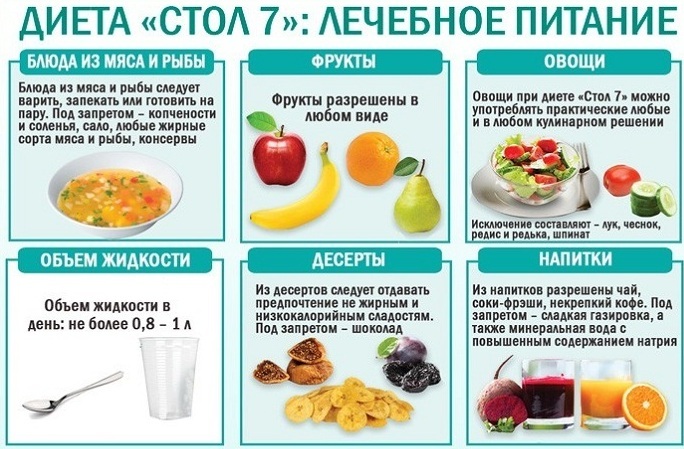
| Allowed Products | Prohibited foods |
|
|
It is recommended to adhere to fractional meals, in small portions up to 5-6 times a day. Drink more water, reduce salt intake.
In the absence of positive dynamics after the application of drug therapy, the patient is shown surgery.
For a child, surgical treatment is always dangerous with possible consequences, but there are certain indications:
- violation of the outflow of urine;
- the formation of large stones in the kidneys;
- purulent damage to the renal blood vessels and nerves;
- abscesses, carbuncles;
- an inflammatory process that medications do not help to eliminate.
After surgery, the child will have a long recovery period, when it also follows adhere to all recommendations of the urologist, surgeon, eat right, avoid training and sports loads.
Consequences of UTI
In the absence of timely diagnosis and correctly selected therapy, the inflammatory process will progress.
Urinary tract infection in children has serious consequences:
| Name | Description |
| Acute renal failure | A pathological condition characterized by impaired renal function is rapidly progressing. A large amount of toxic substances accumulates in the blood. They provoke functional disorders of water and ionic balance.
|
| Deformation of the ureters | The bending of the organ occurs against the background of the prolapse of the kidney. The outflow of urine is impaired. There is a high likelihood of a secondary infection and serious consequences. |
| Violation of the process of excretion of urine | Pathological disorders in the urinary system are accompanied by discomfort and painful sensations. There are problems with the process of urine excretion, body temperature rises, pathogenic flora negatively affects the functioning of the kidneys. |
| Urosepsis | Complication of urinary tract infection when pathogens enter the bloodstream. A dangerous condition for a child that will lead to death if you do not provide the little patient with timely medical care. |
| Abscess | A pathological condition in which the organs of the urinary system cannot cope with their functions due to the accumulation of a large amount of pus in them. More often, an abscess develops against the background of untreated pyelonephritis. |
Repeated recurrence of a urinary tract infection increases the risk of developing reflux nephropathy. A complication of an infectious lesion can also be bacteriotoxic shock, arterial hypertension, secondary paranephritis.
A common urinary tract infection in children can be successfully treated with timely and correct treatment.
The inflammatory process is accompanied by characteristic symptoms, with which it is important to go to the hospital in a timely manner, undergo a comprehensive diagnosis and establish the exact cause of the disease. There is a high probability of not only overflowing the infection into a chronic form, but also the appearance of serious complications.
Video about urinary tract infection in children
A urinary tract infection in a child:

